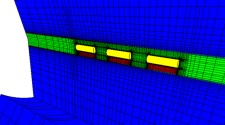
The Full Emplacement (FE) experiment is run by Nagra at the Mont Terri underground rock laboratory (URL) in Switzerland. The experiment tests techniques for the emplacement of waste containers and surrounding backfill, and allows the response of the backfill and the host rock to heat to be studied. Emplacement of the containers and backfill was completed and the heating elements within the containers were turned on in December 2014.
The FE experiment is designed to represent the Swiss concept for disposal of spent fuel and vitrified high-level waste at true scale. A 50 m long tunnel with diameter of 3 m was excavated at the Mont Terri URL in a clay-rich formation (‘Opalinus Clay’). Three heaters, with dimensions similar to those of waste canisters, were emplaced in the tunnel onto pedestals made from bentonite blocks. The remaining space within the tunnel was backfilled with granular bentonite and the tunnel was then sealed with a bentonite plug.
A key aim of the experiment is to investigate the thermo-hydraulic-mechanical (THM) effects of the waste disposal system on the backfill and the host rock. To enable this investigation, around 1500 sensors have been installed within the tunnel and host rock.
Quintessa has been providing modelling support to Nagra for the FE experiment since October 2012. This has included:
- investigations into ventilation strategies and how they will affect the relative humidity of the air in the tunnel and the saturation of the host rock;
- verifying the heat output of the heaters;
- informing the heating strategy; and
- providing predictions of the temperatures that will be observed in the experiment.
A number of different models have been set up for this project using both Quintessa’s software QPAC, and using COMSOL. The models have been used to verify that the experiment is performing as expected while the heaters were turned on and have also been used to make longer term temperature predictions. To date, the temperature data from the region close to the heaters has matched well with the temperature predictions from the modelling.
The FE experiment is expect to run for at least 10 years, and there will be ongoing work to interpret the data collected over this time period and to understand any discrepancies between the predictions that have been made by our models and the data.